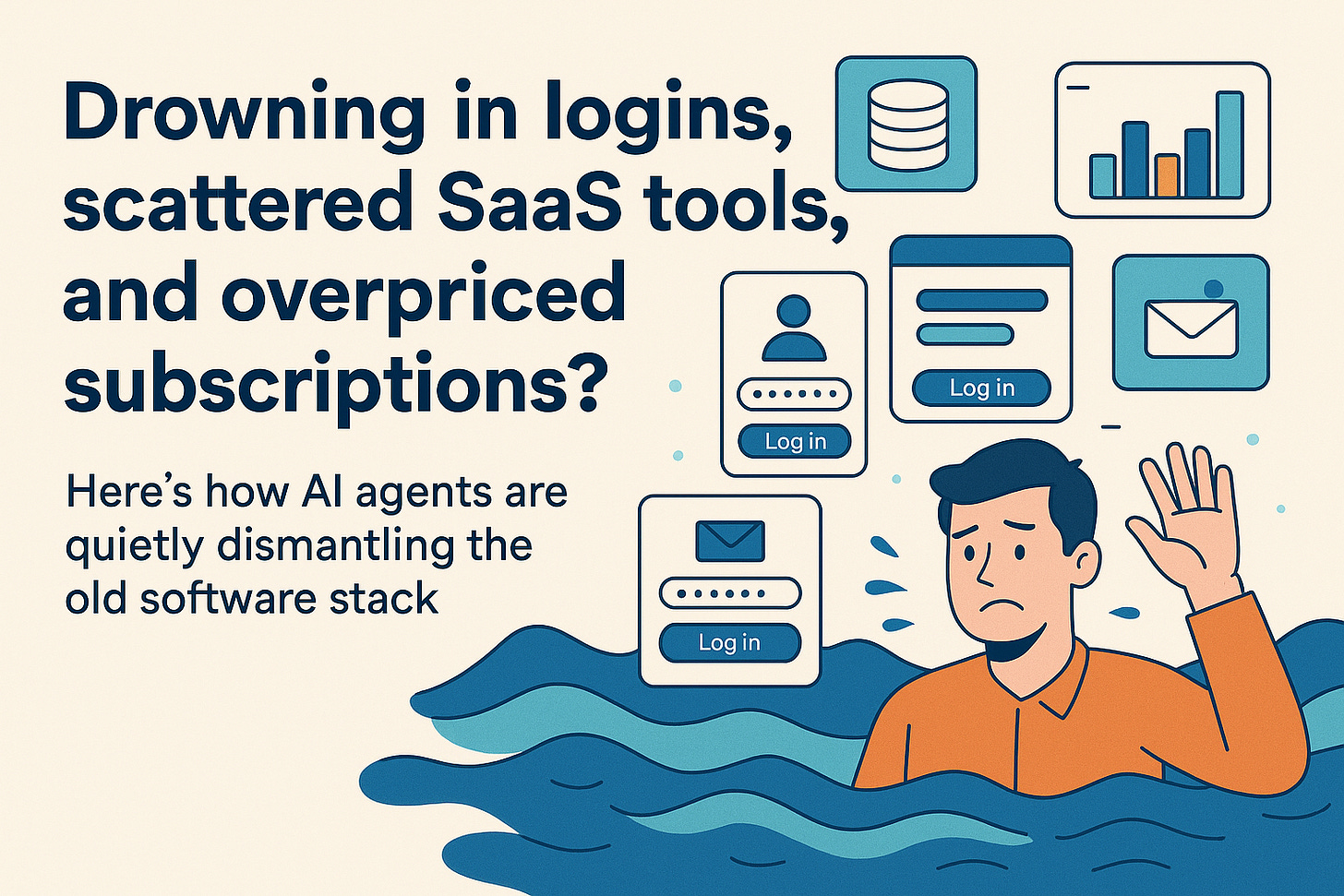Reclaiming Focus: Why SaaS Fatigue Is Fueling the Rise of AI Agents
Drowning in logins, scattered SaaS tools, and overpriced subscriptions? Here’s how AI agents are quietly dismantling the old software stack.
Hi everyone,
Thank you for reading Great CTO. I publish weekly and have an archive of over 150 posts, each packed with valuable insights on various topics relevant to the CTO and the issues they face, distilled from my career experience.
I strive to make each post a helpful resource on the topic it focuses on so that when a CTO has a need, they can reference an atomic nugget of insight. To this end, I regularly revisit and refine posts, ensuring you always receive the best and most up-to-date information with the most clarity.
If you’d like to support the growth of this resource, consider upgrading to paid and take advantage of the other ways I can help you.This is an AI-assisted post based on brainstorming I did with one of my chatbots. It is more intended as a thought starter. Nonetheless, it raises some interesting questions about whether the AI investment bubble will disrupt SaaS businesses.
If you’ve ever caught yourself juggling tabs like a circus act—CRM open in one, docs in another, code tools spread across monitors—you’re not alone. Today’s tech leaders operate in increasingly fragmented environments, where every function demands its own SaaS platform. We’ve added tools to gain efficiency, but in the process, we’ve lost something more valuable: our focus.
Now the cracks are showing. And AI agents might be the wedge driving the next wave of disruption.
The Hidden Cost of SaaS Sprawl
Narrowly focused SaaS tools do one thing well—and that’s precisely the problem. The more comprehensive your needs, the more tools you end up stitching together. For consultants like me, multiply that by every client relationship, resulting in a chaotic web of logins, interfaces, and subscriptions.
The time cost is real:
Authenticating into dozens of tools.
Managing credentials across clients.
Adapting to inconsistent UIs and workflows.
Constantly context-switching to perform basic actions.
Then there’s the pricing model. Per-seat subscriptions and bloated tiers often don’t reflect the value you extract. You pay full price, whether in the app all day or need it for one key function.
These inefficiencies aren’t just annoying—they’re structural. And that’s what makes SaaS ripe for disruption.
AI Agents as the New Interface Layer
Smart money is moving toward AI, not just because it’s shiny and new, but because it targets this inefficiency head-on. AI agents, like Claude Desktop, Cursor, or orchestrators like n8n and Zapier, are increasingly replacing the need to live inside every SaaS interface.
Sure, the integrations are still fiddly. You’ll spend some time up front setting up API keys or designing workflows. However, once configured, the payoff is significant.
I now spend far less time inside individual tools and far more time in front of intelligent orchestrators. I can pull client data, summarise documents, draft replies, and update systems—without touching half the SaaS platforms on which those actions depend.
That’s not just streamlining. That’s reclaiming agency.
For Tech Leaders, This Isn’t Optional
If you lead a team—or serve multiple clients—you’re likely feeling this friction already. The question isn’t if AI will change how you work. It’s how intentionally you’ll adopt it before it becomes standard.
With orchestration tools and AI automation:
You reduce authentication fatigue.
You escape per-seat pricing traps by minimising direct usage.
You adapt workflows to your rhythm, not the other way around.
You unlock insights across tools, without needing to check each manually.
It’s not about replacing SaaS—it’s about decoupling the function from the interface.
So, Where Do You Start?
Here’s a pragmatic path to get going:
Audit your toolset: Where do you spend time managing the tool, rather than using it?
Pick a high-friction workflow: What feels like “too many steps” every time you do it?
Design a lightweight solution: Use Claude, GPT, Zapier, or n8n to test an AI-driven interaction layer.
Iterate toward utility: Don’t automate everything—just the things interrupting your focus.
Over to You
Are AI agents a curiosity for your team, or are you already building your orchestration layer? What’s been your biggest blocker—technical, budget, or mindset?
Q1: What SaaS platform do you wish to use without logging in?
Q2: How much time are you losing to tool-switching and authentication across your week?
Q3: How different would your stack look if you could price SaaS based on actual value delivered?
Let’s talk. The SaaS stack is bloated, the interfaces are clunky, and the margins are wide. That’s not a recipe for sustainability—it’s a sign of coming change.
👀 Coming Soon…
Next week, I’ll continue my theme of AI-assisted development, covering all angles important for technology leaders to make informed decisions on leveraging this fast-evolving technology and what it means for other decisions, such as hiring and budgeting.
Subscribe to get it in your inbox.
If this idea sparked something, share it. Better yet, hit reply and tell me how you’re thinking about team design in the age of AI.
—Daniel
If you enjoyed this publication, please help others find us and benefit from the insights.



Saw this post yesterday, which seems to be a good illustration of the points I made in my post:
https://steipete.me/posts/2025/claude-code-is-my-computer